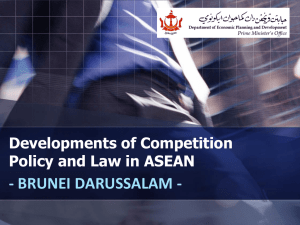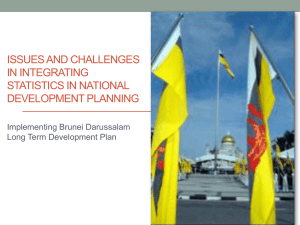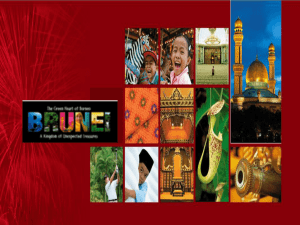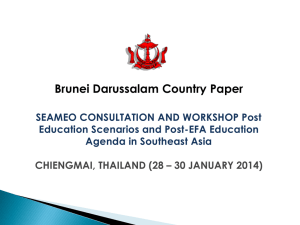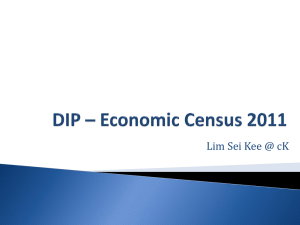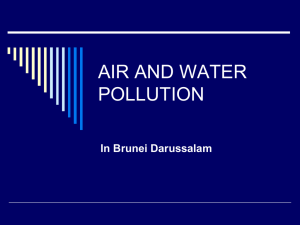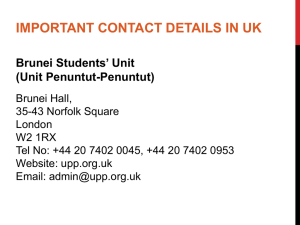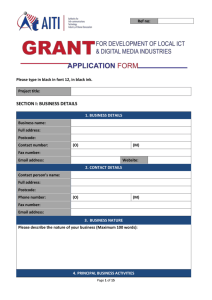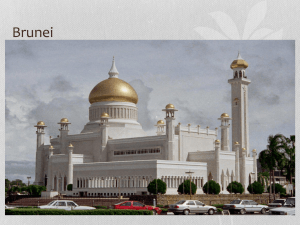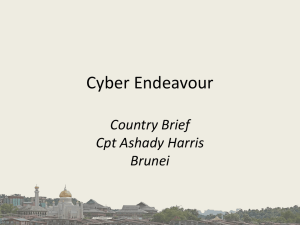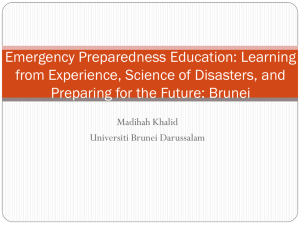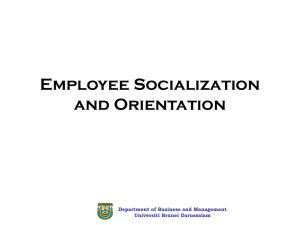Science & Technology in Brunei Darussalam Hazri Kifle, Yeoul
advertisement
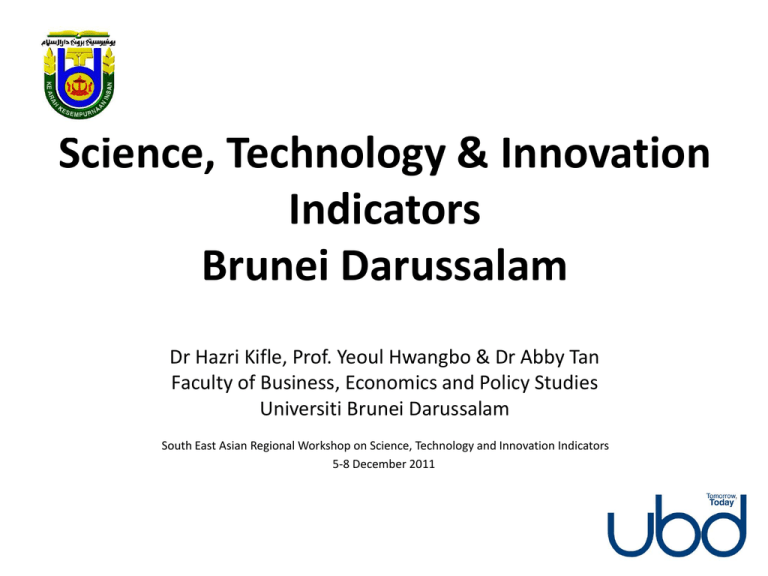
Science, Technology & Innovation Indicators Brunei Darussalam Dr Hazri Kifle, Prof. Yeoul Hwangbo & Dr Abby Tan Faculty of Business, Economics and Policy Studies Universiti Brunei Darussalam South East Asian Regional Workshop on Science, Technology and Innovation Indicators 5-8 December 2011 1 Content 1. 2. 3. 4. 5. General Information of Brunei Darussalam National Economic Development Plan: Vision 2035 Science, Technology & Innovation Key Indicators STI Research Conclusion 2 Brunei Darussalam • Population about 401,890 (July 2011 est.) • Heavy reliance on the oil and gas sector - accounts for more than 70 % of GDP • Per capita – US$48,714 in 2010 • Brunei Vision 2035 – dynamic and sustainable economy 3 Economic Activities Gross domestic product (GDP) BND 20,397.9 million GDP per capita BND 51,251.0 Oil and gas sector BND 14,300.0 million Non-oil and gas sector BND 6,097.9 million <Source> International Monetary Fund, IMF Country Report No.10/134, May 2010 The economy was still very much dependent on the oil and gas sector, of which contribution to GDP was 70.1 %. 4 Brunei Vision 2035 Aims to make Brunei Darussalam, by 2035, as a nation which will be widely recognised for the accomplishment of: • its educated and highly skilled people as measured by the highest international standards • quality of life that is among the top 10 nations • a dynamic and sustainable economy with income per capita within the top 10 countries in the world 5 Current Scenario [Source: Brunei Long Term Development Plan, 2007] Economic growth has not kept pace with population growth The public sector can no longer absorb the growing numbers of young people wishing to enter the work force each year There is a widening gap between the expectations and capabilities of the nation’s youth and the employment opportunities currently being created The oil and gas sector employs < 3% of the work force The local business community continues to be weak and is unable to create the employment opportunities required 6 Roles and Responsibilities • National Science and Technology Committee (NSTC) established in 1994 under the Ministry of Development • Brunei Research Council (BRC) – reformed in 2011 • Provide funding for all research done by Government agencies 7 STI Survey • A preliminary survey was done in 2005/2006 8 STI Survey Brunei R & D Indicators 1995 1996 2000 2001 2002 2003 20041 Gross domestic expenditure on R&D (GERD): Gross domestic expenditure on R&D -- GERD (million current 1.0 PPP $) 1.1906 1.5016 4.7999 1.a GERD (Million B$) 1.666 2.0 GERD as a percentage of GDP 0.022 0.0255 0.053 3.0 GERD -- (million 1995 dollars -- constant prices and PPP) 1.2921 1.5623 4.5404 3.a GERD -- Compound annual growth rate (constant prices) 4.0 GERD per capita population (current PPP $) 5.0 Estimated Civil GERD as a percentage of GDP 6.0 Basic research expenditure as percentage of GDP 2.104 4.9247 NA 20.9 190.6 3.49 4.30 13.34 0.0218 0.0255 0.0531 0.00 0.00 0.0055 99.00 98.00 50.8 NA -1.0 -48.2 8.0 Total researchers per thousand total employment 0.66 0.65 0.32 8.a Total researchers per thousand labour force 0.63 0.62 0.31 R&D Personnel (FTE): 7.0 Total researchers (FTE) 7.a Total researchers -- Compound annual growth rate 9.0 Total R&D personnel (FTE) 9.a Total R&D personnel -- Compound annual growth rate 140.00 140.00 101.9 NA 0.0 -27.2 10.0 Total R&D personnel per thousand total employment 0.93 0.92 0.64 10.a Total R&D personnel per thousand labour force 0.89 0.88 0.62 GERD by source of funds: 11.0 Industry-financed GERD as a percentage of GDP 0.0019 0.0034 12.0 Government-financed GERD as a percentage of GDP 0.0198 0.0222 0.0489 13.0 Percentage of GERD financed by industry 8.840 6.664 0 1.58 9 Key Indicators for R&D Activities 2002-2004 (Source: Brunei Darussalam Long-Term Development Plan, 2007 & Ministry of Development) 2002 2003 2004 Gross Expenditure on R&D- GERD (BND million PPP) 1.19 1.50 4.80 GERD as a % of GDP 0.02 0.03 0.05 Total R&D Personnel per Thousand Labour Force 0.89 0.88 0.62 Higher Education Expenditure on R&D – HERD (BND million PPP) 0.37 0.58 0.36 Business Enterprise Expenditure on R&D –BERD (BND million PPP) 0.00729 0.03512 0.0 • Although there was an increase in the gross expenditure on R&D, the amount of investment on R&D in higher education and businesses were still low. 10 GERD source of funds in Brunei Darussalam [Source: Ministry of Development] Source of Funds 2002 2003 2004 Industry-financed GERD as % of GDP 0.0019 0.0034 0 Government-financed GERD as % of GDP 0.0198 0.0222 0.0489 % of GERD financed by industry 8.840 6.664 1.58 % of GERD financed by Government 91.160 86.776 92.02 11 Comparisons of R&D personnel/ million people (Source: Brunei Darussalam Long-Term Development Plan, 2007) R&D Personnel per million people Brunei Darussalam Singapore Korea Japan 282 4,352 2,979 5,085 • Although there was an increase in the gross expenditure on R&D, the total number of R&D personnel and the amount of investment on R&D in higher education and businesses were still low. 12 Researchers (Source: Brunei Darussalam Long-Term Development Plan, 2007) Researchers (headcount) 2002 2003 2004 Total researchers in Business Enterprise Sector 32 32 N/A Total researchers in Government Sectors 61 62 70 Total researchers in Higher Education Sector 201 198 174 Total Researchers (* Incomplete data) 294 292 244* 13 Issues and Challenges (Source: Brunei Darussalam Long-Term Development Plan, 2007) Absence of a central agency to champion the STI development and identification of specific objectives Issues in coordinating and integrating STI policy Lack of priority Higher Education Institutions tend to focus more of their resources on teaching and training rather than research. 14 Issues and Challenges (Source: Brunei Darussalam Long-Term Development Plan, 2007) The number of researchers involved in R&D was small compared to other countries in the region. The percentage of the population pursuing higher education was small compared to OECD countries. The proportion of the Brunei population with S&T qualifications was also much lower than any of the OECD countries, showing that R&D personnel per million people are 292 and expenditure of R&D as % of GDP is 0.03% in 2003. 15 Issues and Challenges (Source: Brunei Darussalam Long-Term Development Plan, 2007) The expenditure of R&D in this country as percentage of GDP was the lowest. There was also minimal collaboration between higher institutions and private sector in the area of R&D. This was partly due to the fact that majority of local companies did not see a need for any R&D activities. 16 Efforts made for STI in 8th NDP 8th National Development Plan (2001-2005) made explicit reference to the crucial role of S&T and R&D for national development. – A sum of BND 125 million was allocated for the development of S&T and R&D and about 57% of the total allocation was for financing and feasibility studies – Several promotional S&T programmes were organized by various agencies such as the Oil and Gas Discovery Centre (OGDC) and Science, Technology and Environment Partnership Centre (STEP). 17 9th NATIONAL DEVELOPMENT PLAN • 9th National Development Plan (2007-2012) – Science, Technology and Innovation (STI) as the leverage to accelerate growth and national competitiveness • Brunei Darussalam aims to allocate 1% of its Gross Domestic Product (GDP) to research over the next few years • Brunei Research Council (BRC) to set the policy direction in research and development and innovation, identifying priority science and technology clusters for Brunei niche areas • Brunei Economic Development Board (BEDB) to promote foreign direct investment in the non-oil gas and sector, namely health care, pharmaceutical, food and alternative energy 18 9th NDP (2007-2012) Allocated (BND$ Million) Percentage % 1. Industry and Commerce 1,025.0 10.8 2. Transport and Communication 1,067.0 11.2 3. Social Services 3,055.7 32.2 4. Public Utilities 1,492.7 15.7 5. Public Buildings 673.0 7.1 6. Science & Technology and Research and Development 165.2 1.7 1,145.7 12.1 8. Security 596.8 6.3 9. Miscellaneous 278.9 2.9 Sectors 7. ICT A total of BND 9.5 billion has been allocated for National Development Plan (2007-2012) to finance the implementation of 826 projects within 257 programmes. As part of national development plans, S&T and R&D sector are allocated BND 165.2 million which accounts for 1.7 per cent of the total scheme value. 19 Funding and Infrastructure Development for Universiti Brunei Darussalam 20 Specific Research 1 • Development of a comprehensive R&D indicators for Brunei Darussalam based on Frascati Manual • “In an era of rapid technological change, economic growth is increasingly dependent on research and development (R&D). Monitoring industry, government, and university R&D programs is thus crucial to successful policymaking and analysis”. (OECD, 2002) 21 Specific Research 2 • The combination of firms, organisations and institutions for the purpose of innovation - the ‘national system of innovation’ • The nature of the linkages between university, government and industries is under-studied • Collaboration between government agencies, industries and researchers, although they may appear to be unlikely allies, is important as they have a shared interest in innovation and meeting future needs (Scherlis & Eisenberg, 2003). 22 Survey for S&T and R&D Activities • Brunei had conducted the survey till 2004, but have not produced data on S&T and R&D activities, with particular emphasis on (i) Human Resources and (ii) R&D Expenditure since 2005. • In 2012, Brunei to start conducting the survey to produce S&T statistics and thereby provide S&T and R&D information for policy maker. – In order to make sure international comparison, the survey is being conducted in accordance with Frascati Manual 23 STI Survey Details • • • • Reference period – 2004 to 2011 Type of survey – Qualitative and quantitative, Government funding Industrial coverage - Oil and gas, Petro-chemical, and ICT industries Data collection procedure - email, mail, in-person interview, secondary data • Sample size -all relevant Ministries, agencies, research institutes, statutory body, universities, and industry • Main challenges encountered when structuring and carrying out the survey – survey on past periods between 2004 and 2009 • Timeline of the full process – expected completion in 2012/2013 24 Technical Support • UNESCO • Mentor Country • Korean Advanced Institute for Science and Technology (KAIST) • Science and Technology Policy Institute (STEPI) 25 THANK YOU 26 S&T Survey Database and Decision Supporting System (DSS) Gathering Policy Information Survey Activities Decision Supporting DB Survey DB Decision Supporting System Statistics Information System • Survey results will be managed using Database and information system. • IT system and DB will produce statistics of S&T and R&D • The statistics from Survey DB will be converted into decision supporting information for policy makers 27 The Survey Temple: General Information 28 The Survey Template: R & D Human Resource 1. R&D Human Resources Definition of R&D Human Resource - Researcher : Researchers are professionals engaged in the conception or creation of new knowledge, products, processes, methods and systems and also in the management of the projects concerned. - Research Assistant: researchers who are paid by research grants or contracts to work in collaboration with a professor within a faculty, an affiliated research center or an institute. They are not permanent employees because their continued employment depends on continuing support from research grants or contracts. They hold a PhD degree or an equivalent qualification (MD) that would be appropriate for appointment as an assistant professor. - Technician & equivalent staff : persons whose main task requires technical knowledge and experience in one or more fields of engineering, physical and life sciences or social sciences and humanities. They participate in R&D by performing scientific and technical tasks involving the application of concepts and operational methods, normally under the supervision of researchers. Equivalent staff perform the corresponding R&D tasks under the supervision of researchers in the social sciences and humanities. - Clerical staff: Other supporting staff including skilled and unskilled craftsmen, participating in R & D projects or directly associated with such projects. Reference- The Frascati Manual. It is a manual setting out the methodology for the collection of statistics regarding research and development. It was prepared and published by the Organization for Economic cooperation and Development. 2. Age of Researcher The Survey on female researcher is being conducted. 3. Researcher's Major and Degree Engineering Medicine, Pharmacy Civil engineering, Architecture 0 Electric, Electronic, Information, Communication Engineering 0 Mechanical, Aerospace, Atomic Engineering Chemical Engineering Metal, Material, Fiber Engineering Medical Engineering Environment, Resource, Marine Engineering Environmental Bio Engineering Industrial Bio Engineering Nano Technology etc 0 0 0 0 0 0 0 0 0 Medicine 0 Phamacy 0 Nursing, Health 0 etc 0 Agriculture, Forest, Marine 0 Zootechny, Zoology, Dairy 0 Veterinary 0 Agricultural Bio 0 etc 0 History 0 Language and Literature 0 Philosophy, Religion 0 Art 0 Physical Science 0 etc 0 Agriculture Humanities Psychology 0 Economics, Management 0 Education 0 Sociology, Anthropology Social Science Social Welfare, 0 Law 0 Politics, Public Administration, Policy 0 Region, Geography 0 Mass media, Libaray 0 ect 0 Total 0 0 0 0 0 0 0 0 0 4. Foreign Researcher The Survey Template: R&D Expenditure • Fund Source of R&D Expenditure Detailed R&D Expenditure 5. Detailed R&D Expenditure THANK YOU 36
